|
Andrew's Tips: Bagpipe Finger Positions Charts
By Andrew T. Lenz, Jr., Santa Cruz, California, ©2004-2008
There are nine notes most commonly played on the Great Highland Bagpipe. This page shows charts and diagrams for the hand and fingering positions for the bagpipe/practice chanter and explains how to play each of these individual notes as well as a several less commonly played notes.
If you have trouble with any terms, visit my Piper's Dictionary.
The Standard Notes
These nine basic notes—uncommon notes are discussed below—are sounded using the eight finger holes found on the chanter. The holes are named for the note that is sounded when that hole is open. Located on the front of the chanter are seven holes. Located from the bottom up are Low-A through High-G. Located on the back near the top is High-A. (Piper's typically don't refer to a "Low-G hole" as Low-G is sounded when all the finger holes are closed. If anything, such a term would apply to the opening the base of the chanter or, if present, the twin vents located to either side below the Low-A hole.)
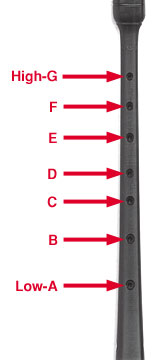 
Finger Locations
On the two hands, the only fingers not used to sound notes are the left pinky—completely unused, if a piper were to choose a finger to be amputated, this would be it!—and the right thumb which simply holds the chanter. Positioning the hands, the left index finger covers the High-G hole, and the right index finger covers the D hole. The rest of the fingers fall into place.
Note: This page is oriented to the standard "right-handed" hand positions. Much like guitars, many left-handed people opt to learn the pipe pipes as a right-hander. One left-handed piper I know wishes he had, in fact, learned as a right-hander. (In his case, simply for uniformity with other band members.) That said, it is perfectly acceptable to play left-handed.
Finger/Hand/Arm Positioning
A few things to know. The chanter is not played with the fingertips, which is a common beginner's error. With the left (top) hand, the holes are covered with the pads of the fingers in front of the joint. With the right (bottom) hand, the holes are covered behind the first joint, with the exception of the pinky which is played with the pad in front of the joint. The top thumb's pad covers the High-A hole. The bottom thumb holds the chanter a little lower than is typically natural, that is, it rests in the vicinity of where the C finger is on the opposite side of the chanter, perhaps a little lower or higher, but definitely below the level of the D finger. The fingers are kept relatively straight, though not locked stiff, just ever so slightly curved. The back of each hand should be parallel with the back of the forearm, not bent in, not bent out. You should be able to rest a ruler along the back of both the arm and the hand without a gap.
When you raise fingers to play notes, they should be raised approximately the thickness of a finger. To be safe, if you were to pass a finger under that raised finger, the passing finger should brush both the chanter and the raised finger. A little higher is fine, you want the finger high enough that the note will sound clearly, but not have "fly away finger syndrome"—you want control. Also a raised finger should stay above its hole so it's ready to come straight down to close the hole, not having to move forward, backward or side to side to meet the hole.
A quick word about that unused high-hand pinky. That pinky will "float" with the E finger, just tagging along with the ride. You don't want to make any effort to force it somewhere it doesn't naturally go. It should have a relaxed natural slight curl. If it goes up when raising the E finger, that's fine. If it goes down when lowering the E finger, that's fine. If you find that it's bumping into the chanter or your other fingers, then you probably need to angle your top hand more—imagine that your index finger is the pivot and you back your E finger away from the chanter a bit. Just ignore your pinky and let it do what it wants to do. After a while, you'll never even think about it.
Common Notes
The following are the very commonly played notes learned by every beginning piper.
 |
Low-G |
| Finger Position/Note |
Hole |
| Left Thumb (A) |
Closed |
| Left Index (G) |
Closed |
| Left Middle (F) |
Closed |
| Left Ring (E) |
Closed |
| Right Index (D) |
Closed |
| Right Middle (C) |
Closed |
| Right Ring (B) |
Closed |
| Right Pinky (A) |
Closed |
|
 |
 |
Low-A |
| Finger Position/Note |
Hole |
| Left Thumb (A) |
Closed |
| Left Index (G) |
Closed |
| Left Middle (F) |
Closed |
| Left Ring (E) |
Closed |
| Right Index (D) |
Closed |
| Right Middle (C) |
Closed |
| Right Ring (B) |
Closed |
| Right Pinky (A) |
—Open— |
|
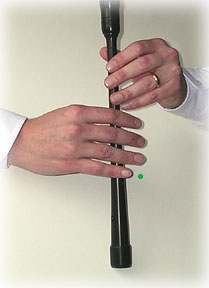 |
 |
B |
| Finger Position/Note |
Hole |
| Left Thumb (A) |
Closed |
| Left Index (G) |
Closed |
| Left Middle (F) |
Closed |
| Left Ring (E) |
Closed |
| Right Index (D) |
Closed |
| Right Middle (C) |
Closed |
| Right Ring (B) |
—Open— |
| Right Pinky (A) |
—Open— |
|
 |
 |
C |
| Finger Position/Note |
Hole |
| Left Thumb (A) |
Closed |
| Left Index (G) |
Closed |
| Left Middle (F) |
Closed |
| Left Ring (E) |
Closed |
| Right Index (D) |
Closed |
| Right Middle (C) |
—Open— |
| Right Ring (B) |
—Open— |
| Right Pinky (A) |
Closed |
Once very common, an "open C" has fallen into misuse—and in competition is marked down by most judges. This "open" fingering is the same the "closed" C above, except the Low-A finger is also raised. |
 |
 |
D |
| Finger Position/Note |
Hole |
| Left Thumb (A) |
Closed |
| Left Index (G) |
Closed |
| Left Middle (F) |
Closed |
| Left Ring (E) |
Closed |
| Right Index (D) |
—Open— |
| Right Middle (C) |
—Open— |
| Right Ring (B) |
—Open— |
| Right Pinky (A) |
Closed |
|
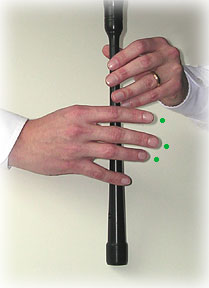 |
 |
E |
| Finger Position/Note |
Hole |
| Left Thumb (A) |
Closed |
| Left Index (G) |
Closed |
| Left Middle (F) |
Closed |
| Left Ring (E) |
—Open— |
| Right Index (D) |
Closed |
| Right Middle (C) |
Closed |
| Right Ring (B) |
Closed |
| Right Pinky (A) |
—Open— |
|
 |
 |
F |
| Finger Position/Note |
Hole |
| Left Thumb (A) |
Closed |
| Left Index (G) |
Closed |
| Left Middle (F) |
—Open— |
| Left Ring (E) |
—Open— |
| Right Index (D) |
Closed |
| Right Middle (C) |
Closed |
| Right Ring (B) |
Closed |
| Right Pinky (A) |
—Open— |
|
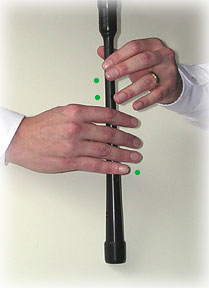 |
 |
High-G (common) |
| Finger Position/Note |
Hole |
| Left Thumb (A) |
Closed |
| Left Index (G) |
—Open— |
| Left Middle (F) |
—Open— |
| Left Ring (E) |
—Open— |
| Right Index (D) |
Closed |
| Right Middle (C) |
Closed |
| Right Ring (B) |
Closed |
| Right Pinky (A) |
—Open— |
|
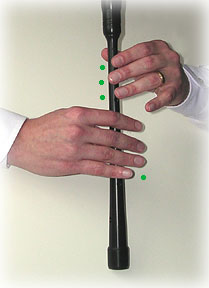 |
 |
High-A (common) |
| Finger Position/Note |
Hole |
| Left Thumb (A) |
—Open— |
| Left Index (G) |
—Open— |
| Left Middle (F) |
—Open— |
| Left Ring (E) |
Closed |
| Right Index (D) |
Closed |
| Right Middle (C) |
Closed |
| Right Ring (B) |
Closed |
| Right Pinky (A) |
—Open— |
|
 |
UNCOMMON NOTES
The following notes are not commonly used by beginning pipers. Piobaireachd notes are used typically only when playing piobaireachds which is a class of bagpiping tunes. Naturals are found in less than one out of every hundred tunes and naturals, when found at all, are typically seen in modern compositions.
Piobaireachd Fingerings
There is no indicated difference on sheet music for piobaireachd fingering, other than they are played for piobaireachd tunes, not marches, jigs or other "light music."
 |
High-G (Piobaireachd) |
| Finger Position/Note |
Hole |
| Left Thumb (A) |
Closed |
| Left Index (G) |
—Open— |
| Left Middle (F) |
Closed |
| Left Ring (E) |
—Open— |
| Right Index (D) |
Closed |
| Right Middle (C) |
Closed |
| Right Ring (B) |
Closed |
| Right Pinky (A) |
—Open— |
Some chanter and reed combinations may have a difficult time sounding a good piobaireached High-G, which should sound ever so slightly flatter than an regular High-G. |
 |
 |
High-A (Piobaireachd or traditional alternate) |
| Finger Position/Note |
Hole |
| Left Thumb (A) |
—Open— |
| Left Index (G) |
—Open— |
| Left Middle (F) |
Closed |
| Left Ring (E) |
—Open— |
| Right Index (D) |
Closed |
| Right Middle (C) |
Closed |
| Right Ring (B) |
Closed |
| Right Pinky (A) |
—Open— |
Piobaireached High-A sounds virtually identical to a regular High-A and in fact, this alternate fingering is used by some pipers for all High-A notes—an uncommon but acceptable practice. (See discussion below.) |
 |
"Natural" Fingerings
C-natural and F-natural are not a commonly played notes, and in fact, on certain reeds and chanter—typically weaker reeds—cannot be sounded correctly. The bagpipe scale includes two implied sharp notes: C and F. When these notes are played as naturals, they come across as minor sounding notes and can put a real twist into a tune precisely because they are uncommon.
 |
C-Natural |
| Finger Position/Note |
Hole |
| Left Thumb (A) |
Closed |
| Left Index (G) |
Closed |
| Left Middle (F) |
Closed |
| Left Ring (E) |
Closed |
| Right Index (D) |
Closed |
| Right Middle (C) |
—Open— |
| Right Ring (B) |
Closed |
| Right Pinky (A) |
—Open— |
|
 |
 |
F-Natural |
| Finger Position/Note |
Hole |
| Left Thumb (A) |
Closed |
| Left Index (G) |
Closed |
| Left Middle (F) |
—Open— |
| Left Ring (E) |
Closed |
| Right Index (D) |
Closed |
| Right Middle (C) |
Closed |
| Right Ring (B) |
Closed |
| Right Pinky (A) |
—Open— |
You may need to experiment and determine if also leaving the C or B holes open will help this note sound correctly with your chanter. |
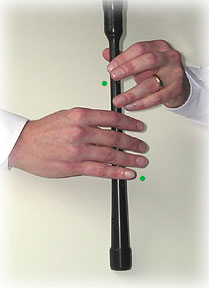 |
Gracenotes
Gracenotes are played by simply lifting the finger for the indicated note. For instance for a D gracenote, the D, C and B are not all lifted, only the D finger is very briefly—but fully, for a beginner—raised. Almost all gracenotes are eventually intended to be played very quickly, sounding like chirps—but exceptions include some notes in piobaireachds shown as gracenotes, but are in fact, played much more like a melody note. Gracenoting is easily learned incorrectly without the guidance of an instructor.
In Closing
This page is intended for reference only and is not intended to replace a qualified instructor, without whom, learning the bagpipes correctly is excruciatingly difficult. You may wish to visit a few other articles of mine: Finding the Right Bagpipe Instructor, How to Become a Rotten Piper, and Learning Bagpipes without an Instructor.
| Some additional insight on Piobaireachd High-A. As noted above, the so-called "piobaireachd High-A" is not commonly seen outside of the piobaireachd genre of pipe music, but it is seen. Terry Lee, the Pipe Major of the World Champion Simon Fraser University Pipe Band, plays only this alternate high-A fingering, even with light music (non-piobaireachd). And while there is a vast divide in skill levels, so does the author of this article! Others, such as Gold Medalist Jimmy McColl, play either version depending on the high-hand note requirements of a given tune. For instance, a lot of High-G and E would lead the player to use the alternate fingering using the F finger as an anchor. On the other hand, if the tune required a lot of High-G and F, the more common High-A with E as the anchor would be appropriate. |
If you have comments regarding this page, please contact me.
This page last updated Sunday, March 14, 2010
Page first created in August 12, 2004.
|
|























